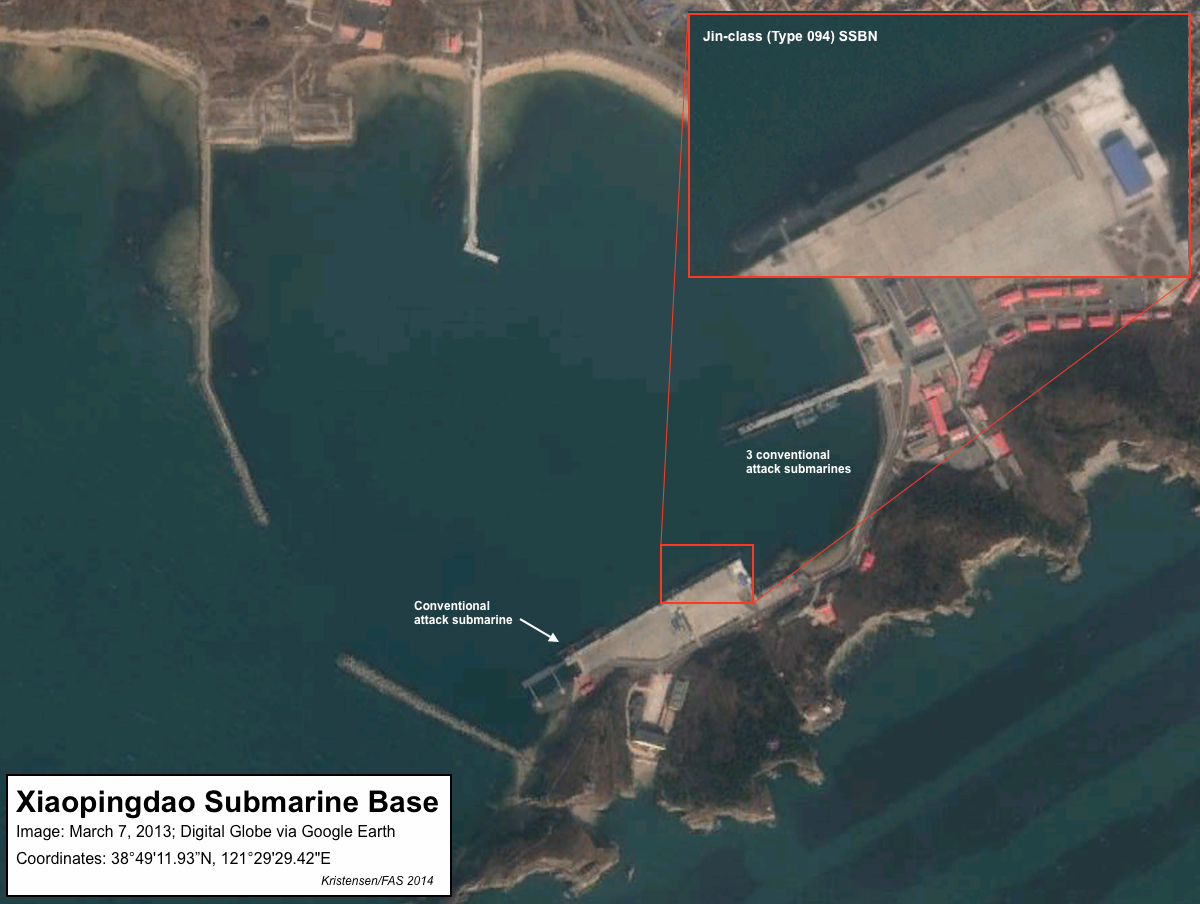China SSBN Fleet Getting Ready – But For What?
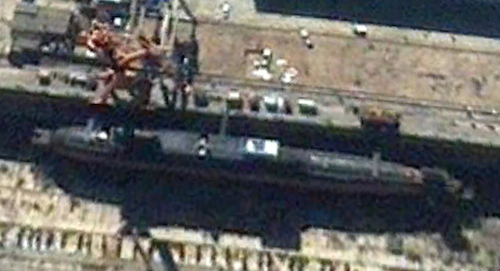 By Hans M. Kristensen
By Hans M. Kristensen
China’s emerging fleet of 3-4 new Jin-class nuclear-powered ballistic missile submarines is getting ready to deploy on deterrent patrols, “probably before the end of 2014,” according to U.S. Pacific Command.
A new satellite image taken in October 2013 (above) shows a Jin SSBN in dry dock at the Bohai shipyard in Huludao. Two of the submarine’s 12 missile tubes are open. It is unclear if the submarine in the picture is the fourth boat or one of the first three Jin SSBNs that has returned to dry dock for repairs or maintenance.
The U.S. intelligence community predicts that “up to five [Jin-class (Type 094) SSBNs] may enter service before China proceeds to its generation SSBN (Type 096) over the next decade,” an indication that the noisy Jin-class design might already be seen as outdated.
This and numerous other commercial satellite images (see below) show how China over the past decade has built an infrastructure of naval facilities to service the new SSBN fleet. This includes upgrades at naval bases, submarine hull demagnetization facilities, underground facilities and high-bay buildings for missile storage and handling, and covered tunnels and railways to conceal the activities from prying eyes in the sky.
Apart from how many Jin SSBNs China will build, the big question is whether the Chinese government will choose to operate them the way Western nuclear-armed states have operated their SSBNs for decades – deployed continuously at sea with nuclear warheads on the ballistic missiles – or continue China’s long-held policy of not deploying nuclear weapons outside Chinese territory but keeping them in central storage for deployment in a crisis.
Nuclear Submarine Sightings
Over the past decade, a total of 25 commercial satellite images made available on Google Earth have provided visual confirmation and information about the status and location of the Jin SSBNs (see table below). They show the submarines at four sites: the Bohai shipyard at Huludao on the Bohai Sea where the submarines are built; the Xiaopingdao naval base near Dalian where the submarines are fitted out for missile launch tests; the North Sea Fleet base at Jianggezhuang near Qingdao where one Jin SSBN is homeported along with the old Xia-class SSBN from the 1980s; and at the South Sea Fleet base at Longpo on Hainan Island where at least one Jin SSBN has been based since 2008.
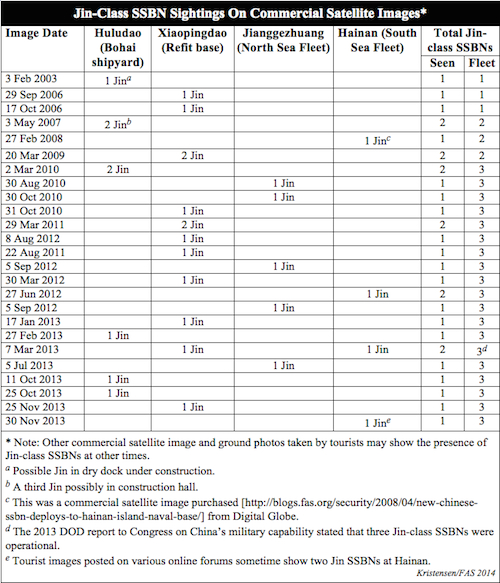
Bohai Ship Yard
The Bohai shipyard at Huludao builds China’s nuclear-powered submarines. The shipyard, which is located in the north of the Bohai Sea, is immensely busy with numerous large tankers and cargo ships under construction at any time. The submarine hulls are assembled in a large 40,000-squaremeter construction hall at the western end of the shipyard, rolled across a storage area into a dry dock for completion, and then launched into the harbor where they spend years tied up to a pier fitting out until handed over to the Chinese navy (PLAN).
Commercial satellite photos provide snapshots of the status of submarine construction and the quality is good enough to differentiate different submarine types and identify design details such as dimensions and layout of the missile compartment. One of the most recent photos (see below) shows a Jin-class SSBN in dry dock with two of 12 missile tubes open. Additional unassembled submarine hull sections are laid out on the ground next to the assembly hall.

The busy Bohai shipyard mixes nuclear submarine construction with commercial tankers and cargo ships in half a dozen dry docks. In this composite image from October 11 and 25, 2013, a completed Jin-class SSBN can be seen in dry dock and what appear to be hull sections for another submarine awaiting assembly. Click for large version.
In addition to satellite photos, tourists also occasionally take photos and post them on Google Panoramio or other web site. One such photo (see below) shows most of the shipyard with other overlaid photos showing dry dock cranes and two missile submarines first seen in 2007.
Xiaopingdao Submarine Refit Base
After completing construction at the Bohai shipyard the submarines sail to the Xiaopingdao refit base near Dalian. This base is used to prepare the submarines for operational service and is where test missiles are loaded into the launch tubes for test launches from the Bohai Sea across China into the Qinghai desert. Xiaopingdao is also used by China’s single Golf-class SSB, a special design submarine previously used to test launch SLBMs.
The base has been upgraded several times over the past decade-and-a-half including an extended pier to service the larger Jin-class SSBNs.
On two occasions, in March 2009 and March 2011, two Jin SSBNs have been seen docked at Xiaopingdao at the same time.
Xiaopingdao is also where the first Jin-class SSBN was spotted on a commercial satellite photo in July 2007.
Jianggezhuang (Laoshan) Submarine Base
The oldest nuclear submarine base is the North Sea Fleet base at Jianggezhuang (Laoshan) approximately 18 kilometers (11 miles) east of Qingdao in the Shandong province.
The Jin-class SSBN was first seen at Jianggezhuang on a commercial satellite image in August 2010.
The base is also home to the old Xia-class SSBN, the lone unit of China’s first experiment with ballistic missile submarines. The Xia completed a multi-year dry dock overhaul in 2007 but has probably never been fully operational and has never conducted a deterrent patrol.
This base is where we in 2006 spotted the long-rumored submarine cave, also described in Imaging Notes. The cave has a large water tunnel with access from the harbor and three land-tunnels providing access from various base facilities.
A satellite image from July 2013 (see below) shows both the Xia and a Jin SSBN at the base, with the Xia being assisted by two tugboats. Water turbulence behind the submarine indicates the Xia’s engine is operational.
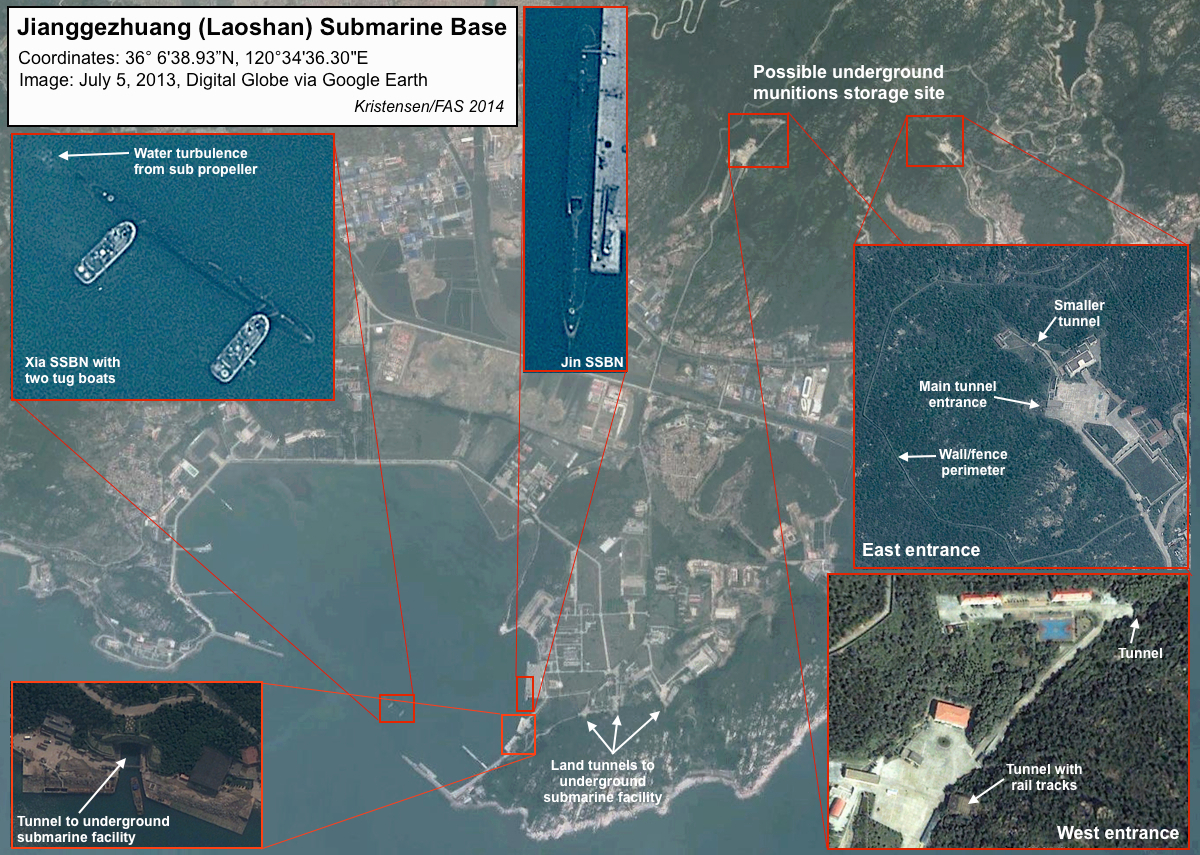
Both Jin- and Xia-class SSBNs are based at Jianggezhuang submarine base, which includes an underground submarine cave. A possible underground weapons storage site is located northeast of the base. Click for large version.
Jianggezhuang also has a dry dock, the only one at a naval base that has so far been seen servicing nuclear-propelled submarines. There are also several nuclear-powered attack submarines homeported at the base.
Only a few miles north of the base is an underground facility that may be storing munitions for the submarine fleet. As such, it could potentially also serve as a regional storage facility for nuclear warheads for the SLBMs once released to the navy in a crisis by the Central Military Committee.
Several buildings have been added since 2003, possibly in preparation for accommodating the new Jin SSBN and its larger JL-2 SLBMs.
Hainan Island Submarine Complex
The South Sea Fleet naval facilities on Hainan Island are under significant expansion. The nuclear submarine base at Longpo has been upgraded to serve as the first nuclear submarine base in the South China Sea. The first Jin-class SSBN was seen at Longpo on February 27, 2008, and a new photo from November 2013 shows a Jin SSBN with its missile tubes open (see below).
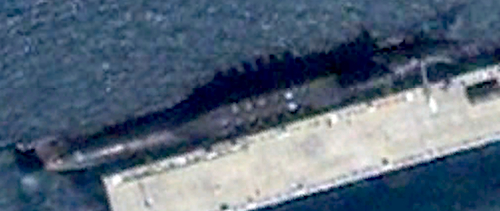
In this image from November 30, 2013, a Jin-class SSBN can be seen flashing its 12 missile tubes while docked at Longpo naval base on Hainan Island.
Longpo submarine base includes four piers for submarines, an underground submarine facility with tunnel access from the harbor and land-tunnels from the other side of the mountain, as well as a demagnetization facility. Longpo was the first base to get a demagnetization facility, which has since also been added to the East Sea Fleet near Ningbo.
The Hainan naval complex also includes the conventional submarine base at Julin, which also appears to be under expansion with new piers and a sea break wall under construction.
Approximately 12 kilometers (7 miles) northeast of Longpo is a military facility that appears to include four tunnels connecting to one or several underground facilities inside the mountain. Tugged away at the end of a lake inside a valley, the facility has a significant infrastructure with administrative and technical buildings as well as several camouflaged high-bay buildings surrounded by berms for blast protection during explosives handling.
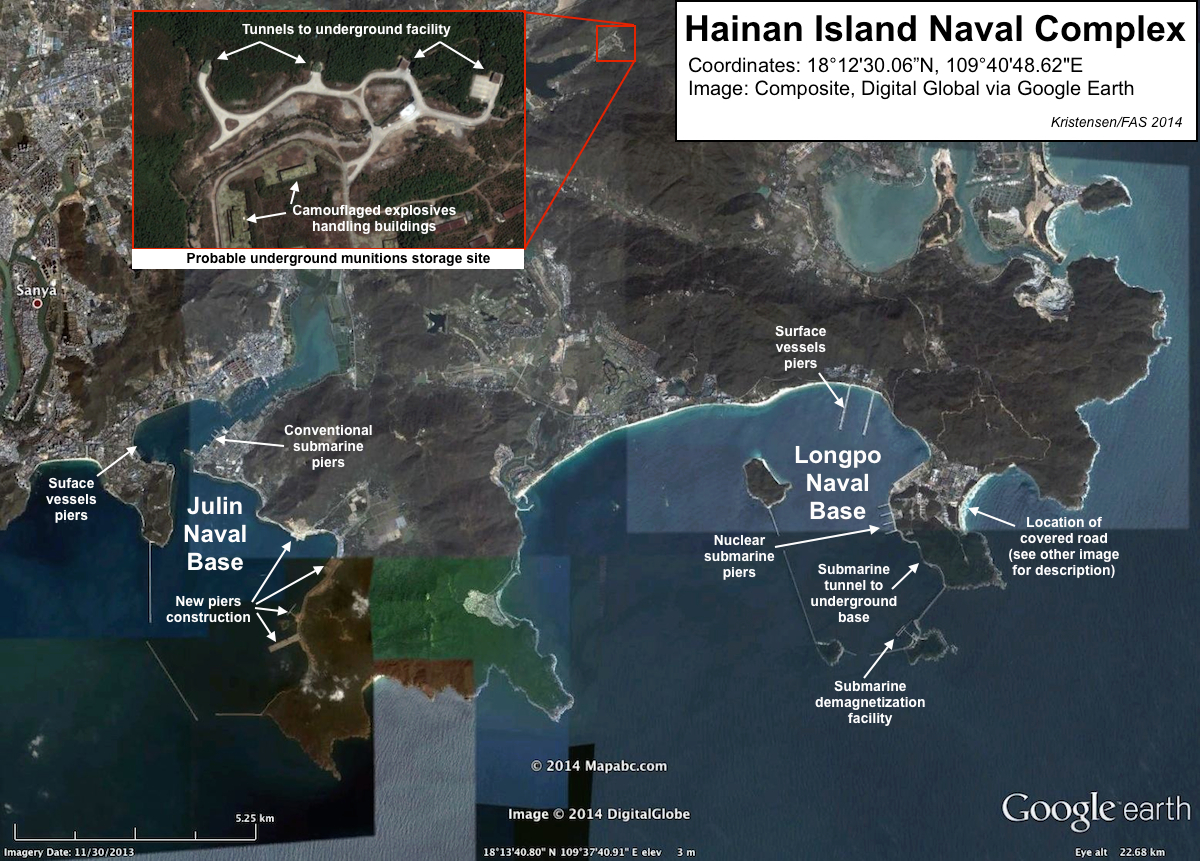
The naval complex on Hainan Island is spread across several locations with nuclear submarines based at Longpo, conventional submarines based at Julin, and a possible underground weapon storage facility north of the bases. Click for large version.
The Longpo base does not have a dry dock so nuclear submarines would have to sail to another base for maintenance or repair. The conventional submarine base at Julin has a 165-meter (550-feet) dry dock that could potentially accommodate a Jin-class SSBN, but it would be a tight fit. More likely are the 215-meter (706-feet) dry docks at the Zhanjiang Naval Base on the mainland north of Hainan Island, or the East Sea Fleet submarine base near Ningbo. Yet so far available commercial satellite images have not shown a nuclear submarine at either Julin, Zhanjiang (South Sea Fleet headquarters), nor Ningbo (East Sea Fleet headquarters), and it is unclear if the bases are certified for nuclear-propelled submarines. If not, then nuclear submarines based on Hainan Island would have to use a dry dock as far north as Jianggezhuang or Bohai for maintenance and repairs. That seem strange so I’m sure I’ve missed a naval dry dock somewhere closer to Hainan.
A unique new feature at Longpo is a 1.3-kilometer (0.8-mile) long covered railway completed in May or June 2010 (see below). The railway connects a high-bay building with possible access into the mountain at the eastern part of the base with one of the land-based tunnels to the underground submarine cave on the Longpo peninsula. The covered railway clearly seems intended to keep movement of something between the two mountains out of sight from spying satellites. Two turnoffs from the railway lead to a large building under construction with rail tracks inside. The purpose of the new facilities and rail is unknown but might potentially be intended for movement of SLBMs or other weapons between storage inside the mountain to the submarine cave for arming of SSBNs or SSNs.

A new covered railway constructed in 2010 might connect a missile handling building with the submarine cave on the other side of the mountain. Click for large version.
Before a roof was constructed to conceal the land-tunnel into the submarine cave, the rail tracks into the tunnel were visible on satellite images. Other features at this portion of the base include five ventilation stacks, the roof between the covered railway and tunnel entrance, and a coverage being constructed over a second tunnel road entrance (see above). These features are also visible on a tourist photo posted on Google Panoramio (see below).
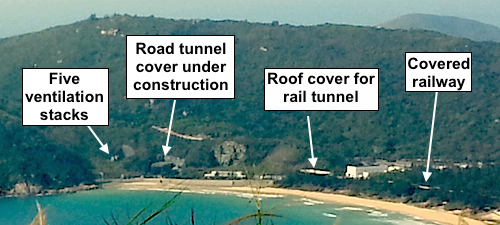
The east side of the underground submarine cave at the Longpo naval base on Hainan Island includes rail- and road-tunnels, ventilation stacks, and a covered railway.
Implications
With the emerging Jin-class SSBN fleet, China appears ready to add an important component to its nuclear deterrent. Although the focus of China’s nuclear posture is the land-based missile force, the Chinese leadership appears to view a triad of nuclear forces as a symbol of great power status. Commercial satellite images clearly show that the Chinese leadership has been spending considerable resources over the past decade building the infrastructure needed to support the SSBN fleet. The development is watched closely in India, Japan, and the United States as an example of China’s (modestly) growing and more sophisticated nuclear arsenal.
In building the Jin-class SSBN fleet, however, China appears more to mirror the nuclear postures of the United States, Russia, Britain and France rather than demonstrating a clear purpose and contribution of the SSBN force to China’s own security and crisis stability in general.
As a new second-strike capability added to the Chinese nuclear arsenal, the Jin SSBN fleet only makes strategic sense if it is more secure than the Second Artillery’s land-based ICBM force. Its justification must be based on a conclusion that the ICBMs are too vulnerable to a first strike and that a more secure sea-based second-strike force therefore is needed.
The ultimate test of the Jin SSBNs will be whether they can survive long enough at sea in a hypothetical war situation to provide a back-up deterrent at all. If they are too noisy, the Jins could be vulnerable to early detection and attrition, especially if they had to deploy to distant patrols areas in order for the missiles to be able to reach important targets. With a range of 7,200 to 7,400 kilometers (4,470 to 4,600 miles) – the range estimate given by the U.S. intelligence community for the JL-2 SLBM carried on Jin-class SSBNs, a submarine would need to sail deep into the Pacific Ocean to be able to target the U.S. west coast. To threaten Washington DC, a Jin SSBN would have to sail halfway across the Pacific (see map below). Not exactly safe travel for a submarine that is noisier than the ancient Russian Delta III SSBNs built in the 1970s.
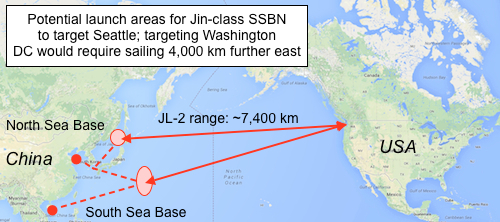
It is probably a fair assumption that U.S. attack submarines have already been trailing or monitoring the Jin SSBNs to record individual sound characteristics and observe operational patterns. Such information would be used to locate and, if necessary, sink the Chinese submarines in a hypothetical war.
The value of the Jin SSBNs is also dependent on their capability to communicate with the national command authority on land from submerged patrol areas. Secure and reliable communication is essential for the Chinese leaders to be able to exercise command and control of the nuclear missiles on the SSBNs. If communication is poor, the SSBNs could become irrelevant or, perhaps more importantly, downright dangerous to crisis stability if loss of contact caused Beijing to mistakenly conclude that one or more of the subs had been sunk by enemy action. That could, potentially, cause the Chinese leadership to conclude that the nuclear threshold had already been crossed and decide to activate its land-based nuclear forces in a way that would be seen by an adversary as preparation to launch.
Some of these issues may become clearer when China begins to operate the Jin submarines as a real SSBN force. Part of the public debate has been somewhat overblown with claims that Jin SSBNs will be able to target the continental United States from Chinese waters. They will not. And the DOD assessment that the Jins “will give the PLA Navy its first credible sea-based nuclear deterrent” is probably premature and certainly depends on what is meant by “credible.”
Whatever their ultimate capability may be, however, the Jin SSBNs and the infrastructure China is building are symbols of the extensive nuclear modernizations that are underway in all the nuclear-armed countries. The Chinese government says it “will never enter into a nuclear arms race with any other country,” but it is certainly in a technological race with the United States, Russia and India about developing improved and more capable nuclear weapons.
Additional resources: Previous articles about Chinese nuclear forces | Most recent (2013) Nuclear Notebook on Chinese nuclear forces.
This publication was made possible by a grant from the Ploughshares Fund. The statements made and views expressed are solely the responsibility of the author.
A military depot in central Belarus has recently been upgraded with additional security perimeters and an access point that indicate it could be intended for housing Russian nuclear warheads for Belarus’ Russia-supplied Iskander missile launchers.
The Indian government announced yesterday that it had conducted the first flight test of its Agni-5 ballistic missile “with Multiple Independently Targetable Re-Entry Vehicle (MIRV) technology.
While many are rightly concerned about Russia’s development of new nuclear-capable systems, fears of substantial nuclear increase may be overblown.
Despite modernization of Russian nuclear forces and warnings about an increase of especially shorter-range non-strategic warheads, we do not yet see such an increase as far as open sources indicate.

